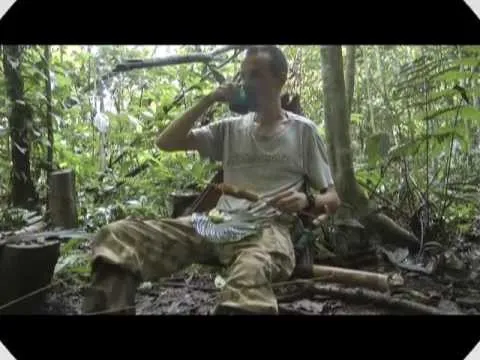You're lost. You're cold, thirsty— you're hungry. What if you're not much of a hunter? Maybe you're a gatherer. So, then you'll eat plants. But what if you eat something poisonous? What if you're allergic to it?
Okay, so not many people will find themselves in a situation where they will actually need to gather unknown plants and devour them for survival, but knowing what to do may just save your life one day, if needed. But who is the one person who should definitely have this knowledge? — A soldier.
One thing everybody should be taught before heading to the vast sandpit of Iraq or the mountains of Aghanistan is survival. Not just as a team, but as an individual, a so-called "army of one".

Most soldiers can't fathom the idea of being left alone, and there's the infamous buddy system to thank for that. Usually, every hour of every day, you're attached to your personal buddy's hip. You eat with him, sleep by him, and sometimes you can't even go take a leak without him. Then you and your buddy are attached to your fire team's hip, and your fire team is attached to your squad's hip, and them to your platoon's, and to your company's… to your battalion's. There's hardly any time throughout the day that a soldier is actually alone.
But what if, amidst a firefight, you get left behind in the chaos? What if the worst happens and you're all alone? What if your platoon just flat out forgets you? Besides waiting for somebody to come and save you, you're going to have to consider what you're going to eat. You might not ever have to use this knowledge. The chances are slim to none, but somebody might just have to. So, whether you're in the Army or the Marines, the Air Force or the Navy, whether you're a Ranger or a Seal, a private contractor with Blackwater, or whether you're just somewhere caught in the middle of the Iraq War, then this could save your life sometime. If you're headed to the land of endless sand, you might want to know how you will survive alone, without MRE's.
And this isn't just helpful survival skills for the military— everyone should know this. Whether you're an avid hiker or mountaineer, boy scout or stranded motorist, there's always a chance you can get stuck in the woods alone. What plants are safe to eat and how do you know?
*This article deals specifically with Iraq, but could be applied to any country or land.
General Plant Life in Iraq
THE CONDITIONS
Iraq provides some very sparse conditions for vegetation, with alluvial soil full of humus and clay, or light soil cursed with high saline quantities due to droughts. Below are a couple photos of these soils.




Near Al Iskandariyah, there's huge lakes of salt deposits untouched, while near Fallujah and Baghdad, there's sparse, but lively greenery, thanks to the Tigris and Euphrates Rivers. Below is a satellite map of the salty lake in-between Iskandariyah and Al Musayyib.

The rivers themselves are high in salt content, bringing a silty loam to most areas, but some land is actually well irrigated and can provide a decent climate for crops and plant life. In southern Iraq, the marshlands provide nourishing conditions for growth, while in northern Iraq, the mountains by the rivers flourish in vegetation.
COMMON VEGETATION
 In Iraq, some of the most common types of vegetation are dinky shrubs and lanky trees. Among the salty desert soils, Halocnemum strobilaceum (right) is one of the most common plants. The succulent halophyte shrub has adapted to the high saline content, and is commonly grazed upon by sheep and camels, which means it might be safe to eat (but don't take my word for it).
In Iraq, some of the most common types of vegetation are dinky shrubs and lanky trees. Among the salty desert soils, Halocnemum strobilaceum (right) is one of the most common plants. The succulent halophyte shrub has adapted to the high saline content, and is commonly grazed upon by sheep and camels, which means it might be safe to eat (but don't take my word for it).
Other plants you might see in Iraq are the Seidlitzia rosmarinus (below), which is also a halophyte shrub. These plants are also eaten by grazing animals, but just the aerial parts.

Catha edulis (below), known as khat or qat, is an evergreen shrub more common in southern Iraq. It's edible, but I'd watch out because the leaves are usually chewed as a stimulant with hallucinatory and euphoric effects that can cause psychological dependence.

Then there's Pistacia palaestina (below), we know it as a type of terebinth. Some forms of this tree bear fruit, which are edible to all, humans and animals.

Besides shrubs and trees, there's plenty of different vegetation, like the cultivated date palm tree (Phoenix dactylifera), poplars, bushes, shrubs, grasses, and thickets of reeds around the marshlands, rivers, and even the irrigation ditches. There is also the colocynth (Citrullus colocynthis), which grows naturally in Iraq and bears fruits, but I wouldn't eat them because they contain a purgative (or laxative) used primarily as a derivative against rodents. The only thing I would consider safe to eat are the dates, everything else I would test first. Below are a few photos of common vegetation found in Iraq.










CROPS
Aside from all of the naturally occurring vegetation in Iraq, there's a plethora of farmers growing various crops in the desert, mountains, and near the rivers. There's crops of grains, grapes, figs, barley, wheat, watermelons, tomatoes, cucumbers and oranges. Below is an image of common farmland and of a woman carrying wheat to her home.




If I were to get stuck alone in the desert, these crops would be the first things I turned to, but only at night to avoid detection.
Now that I've filled you in on some of the plant life and crops in Iraq, it's time to tell you how you go about eating the various plants that you may come across. If you have any doubt that a plant is safe to eat, this test must be performed.
The Universal Edibility Test
REASONS
Okay, the reasons for performing this universal edibility test are obvious: you need to eat, and you're not sure if your plant dinner is actually edible. There's always that small, teensy-weensy chance that you could end up alone in the Iraq desert. The best thing you can do is avoid hostiles, or any local for that matter, so your only option may be to munch on your surroundings until rescued. If you can't stand the thought of eating a scorpion or a snake, then you're only left with plants.
WARNINGS AND ILL EFFECTS
Tasting or swallowing unknown plants can lead to intense discomfort, internal trauma, and possibly even death. There are plenty of things that you could experience if you don't take the necessary precautions, like an upset stomach, drowsiness, disorientation, nausea, trembling, diarrhea, skin irritation, kidney inflammation, burning rashes, abdominal pain, impaired vision, an abnormal heart rate, convulsions, corneal erosion, and even neurological disorders. If you have any allergies, the symptoms could be even worse, like cardiac arrest. I would be extremely cautious when eating anything, because the last thing you would want is to be the next Christopher McCandless, so play it safe and test everything out beforehand.
PREPARATIONS
There is no easy test for discerning poisonous plants from those safe to eat, but this is your best bet. This edibility test seems simple, but is very time consuming. To perform the test properly, you need to set aside 24 hours, which can be exhausting and cause impatience.
Make sure the plant you are testing is abundant around you, because there's no use wasting 24 hours on one plant. You need to have a surplus to make testing worth your time and effort, because once you know it's safe to eat, you can survive solely off that one plant alone, without having to perform another test. So, you can dig in wherever you decide to perform the test, near the plants you're eating, or you can do it on the run, which means you need to take a sufficient supply of everything with you. Unless you know aide is coming, taking it on the go could be your best option.
In order to perform this test, you will also need to fast. There's no way you can tell if a plant is safe for eating if you're eating something else. You will need to start fasting about 8 hours before the test, and you will only be able to drink purified water during.
AVOID
Before you begin testing plants for edibility, I would recommend you stay away from any unknown plants with certain characteristics, like ones resembling mushrooms, onions, garlic, parsley, parsnip, and dill. Although all of the said items are edible, there are many look-alikes out there that are actually poisonous. Also, I'd stay away from any plants with carrot-like leaves, roots, or tubers. You should also avoid anything with a milky liquid sap, or a sap that darkens when exposed to air.
Avoid plants with thorns or spines, avoid fungi, avoid plants that are infested with worms, insects, and other parasites, avoid hairy plants, bulbs, old and wilted leaves, and anything with a strong odor or that you think may be toxic.
So, now you know the basics, so start learning the procedure:
Fast
When you find the plant you will be testing, you will need to fast. Do not ingest anything 8 hours before except purified water, and do not eat anything during the duration of the test. So if you have an emergency MRE or other food rations, keep it wrapped up until this test is complete.

Organize
Pick your plant and break it up into all of its basic components. One part of a plant can be edible, while another can be poisonous, so to correctly perform this test, you need to test each part individually. Organize the basic plant parts, like the leaves, roots, stems, buds, and flowers.

Decide which section you would like to test out, which is usually the more plentiful one. There's no point in testing the smallest portion, because it isn't worth your time. I would also inspect all parts of the plant for any past or present parasitic infestation before you move along to the next step.
Smell
After you have your separated plant parts, smell them for strong odors. Smell does not indicate alone whether a plant is edible or inedible, but it's best to avoid anything that smells strongly or acidy.
Contact
During your 8 hour preparatory fast, you'll need to test the plants for contact poisoning. If you've been handling the plants already and have had an irritation or other reaction, find a new test subject. If you haven't, that doesn't mean it's safe.
Place a small portion inside your elbow or wrist and rub it in gently. If there's sap or other liquid, make sure it touches the skin, too. It's generally a non-contact poisonous plant if there is no irritation after 15 minutes. However, if any irritation should arise during the 8 hours of abstaining from food, it should be considered poisonous and abandoned.
Prepare
Make a small portion of the plant part, and prepare it for how you plan to eat it. If you are planning on cooking the plant, test it cooked, because some poisonous plants can be edible if cooked. In Iraq, cooking is only a good idea if you plan to stay in one spot for a while and plan on making a Dakota fire hole. I would recommend testing raw because it helps you avoid staying in one place too long, where hostile detection is more likely to occur.






Lips
Before you actually eat the plant, you're going to have to test it out on your lips first. Take a small pinch of the portion and touch it to the outer surface of your lips and hold. Wait 3 or 4 minutes for a reaction. If there is no burning or itching, it's safe to continue testing.
Tongue
Your lips have passed the test, now it's time to try your tongue. Place and hold the plant part down on your tongue for 15 minutes. If there is no reaction of any kind, it's time to chew.
Chew
Take a pinch of the test plant part and chew it in your mouth. Do not swallow during this step! If there is no noticeable burning, itching, numbing, or stinging reaction, you can move on to ingesting.
Swallow
It's time to step it up and begin the dangerous part of the test— swallowing. Swallow the small pinch already in your mouth from the previous step.
Wait
This is the hard part of the test, because you just sit and wait, wondering when you'll break out into a rash or fall facedown on the desert sand. Wait 8 full hours after swallowing the small portion, and continue not to eat or drink anything else except purified water.
If any ill effects occur during this 8-hour period, any at all, it's time to induce vomiting. If you have irritated skin, an upset stomach, dizziness— anything, force yourself to vomit immediately.
More
If you're not frantically itching, convulsing on the ground, or flat out dead, chances are the plant section could be safe to eat. But don't go all out yet— eat a 1/2-cup of the same plant part, prepared the exact same way. Since you're in the desert, and you probably don't have a measuring cup, you can judge it with your 1-quart (equals 4-cups) canteen cup or just use your hands. Most soldiers in Iraq don't carry canteens anymore; they just carry bottled water. So, fill up the palm of your hand and you've got nearly a 1/2-cup.

Wait Again
Yes, another 8-hour waiting period is in order. Do not eat or drink anything else again, except the purified water. If no ill reaction occurs, that part of the plant is safe to eat, and only that part.
If you plan on eating any other part of the plant tested, you will have to forego another round of tests for that part. It's a laborious process, but if there are large quantities, it may be worth it. Start over at the beginning of this test to try again. If at any point during this test you had a reaction, then start the test again with a different part of the plant, or with a totally different plant. Just wait until the ill symptoms subside before starting again.
This test should only be done in case of an emergency. I would never try it unless I was abandoned by my lonesome in the desert, jungle, or mountains without food and a reasonable plan of action. If you ever get stranded, make sure you have a map and compass, don't rely on anybody to help you out. Make sure you know where you came from, where you are, and where you're going in relation to the map. If you have a GPS, then great— until the battery dies. But now you know how to prepare your own meals in case of an emergency, whether in the deserts of Iraq or in the forest in your backyard. Good luck!






















Comments
Be the first, drop a comment!